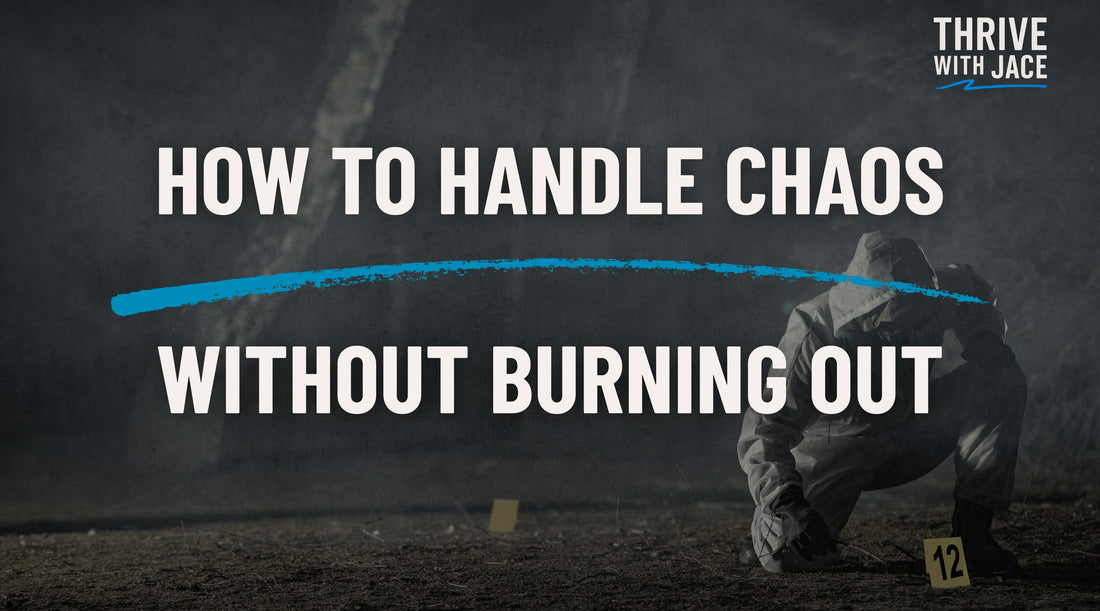
How to Handle Chaos Without Burning Out
Share
Some people think chaos is the problem.
It isn’t.
The real problem is the lack of structure when chaos hits.
You don’t burn out just because life’s hard.
You burn out when you’re constantly reacting, with no rhythm, no system, and no anchor.
I learned that the hard way.
And if you’re feeling like everything’s just a bit too much right now, this one’s for you.
Chaos Doesn’t Warn You
It doesn’t show up politely.
It smashes into your week. The phone rings. A text lands. A crisis brews. Something kicks off at work. Someone lets you down. Plans fall apart. Sleep disappears.
And suddenly, you’re in survival mode — sprinting on adrenaline, skipping meals, cancelling rest, forgetting what day it is.
You think, “Just get through this, then I’ll reset.”
Except the chaos keeps coming.
This is the cycle most people live in.
Constant fire-fighting. No breathing space.
Eventually, it wears you down to the bone.
That’s burnout. Not the glamorous kind. The slow, quiet kind that makes your body ache and your mind feel like static.
What I Didn’t Know at First
Years ago, I thought burnout came from doing too much.
But I’ve worked 14-hour shifts in brutal conditions and felt fine. Energised, even.
Other times, I’ve worked half that and felt fried.
So what’s the difference?
It’s not the hours. It’s not the workload.
It’s the lack of structure when things are unpredictable.
The absence of rhythm. The mental and emotional load of always being on the back foot.
And when I figured that out, everything changed.
Chaos Needs Structure, Not Control
Let me be clear. You don’t need to control everything. You can’t.
What you need is something solid to fall back on when things get wild.
When I’m dealing with a major scene, a high-pressure deadline, or even just life stuff going sideways, I go back to basics.
And I mean the boring, unsexy stuff most people skip:
- Morning check-in
- Water before caffeine
- Breathing space between jobs
- A hard stop in the evening
- A meal I didn’t grab out the fridge door
- One simple win ticked off before 9am
Those things don’t seem like much.
But they’re the difference between holding the line or falling apart.
The Warning Signs You’re Sliding
If you want to stay out of burnout, you’ve got to catch the slide before it becomes a collapse.
Here’s what I look for:
- Snapping at people who don’t deserve it
- Sleeping less but still feeling wired
- Skipping things I normally enjoy
- Getting tunnel vision — hyper-focused but scattered
- Feeling detached from myself, like I’m watching life from the outside
When I see those signs, I don’t judge myself.
I intervene.
Not with a holiday. Not with a bubble bath.
With structure.
My Go-To Chaos Toolkit
This isn’t theoretical. These are the things I actually do when I’m deep in chaos.
1. Reset Routine
Even if it’s five minutes.
Sit. Breathe. Write three things:
- What’s urgent?
- What’s important?
- What can wait?
Then act on one thing only. The rest can sit.
2. Anchor Habits
No matter how messy the day is, I hit three anchors:
- Movement (a walk, a stretch, a gym session if possible)
- One proper meal (no skipping)
- One moment of stillness (even if it's in the toilet at work)
These stop the emotional spin. Every time.
3. Control Your Inputs
When chaos hits, cut the noise.
Limit social media. Don’t open every group chat.
Stick to one voice you trust if you need advice.
Clear out the clutter, mentally and digitally.
4. Check the Story You’re Telling Yourself
Chaos feels worse when your self-talk spirals.
If your head’s saying, “I can’t cope” — challenge it.
You’ve coped before. You’ll cope again.
This might be hard, but it’s not beyond you.
Your words matter. Especially the ones you say when no one’s listening.
What’s Burnout, Really?
Burnout isn’t weakness. It’s data.
It’s your body and brain saying, “Something about how you’re living isn’t sustainable.”
Listen to it.
If you're constantly fried, it doesn't mean you're doing too much.
It might mean you're doing too much of the wrong stuff and not enough of what actually keeps you stable.
And the fix isn’t always dramatic.
It’s often just one small act of structure, repeated consistently, that helps you regain energy and focus.
Don’t Wait for the Chaos to End
That’s the biggest trap.
People think, “Once this blows over, I’ll get my life back together.”
But life doesn’t work like that.
There’s always another thing. Another drama. Another crisis.
If you only feel in control when things are calm, you’ll spend 80 percent of your life feeling behind.
Learn to build stability inside the chaos.
That’s what resilience is.
Not bouncing back.
Not being tough for the sake of it.
Just showing up — clear-headed, grounded, honest — when everything else is up in the air.
If You’re Drowning in Chaos Right Now…
Start here:
✅ The 3-Day Resilience Reset
Quick wins, honest prompts, and a structure you can follow without needing motivation. Built for chaos. It’s free.
📖 Grab the free 30-page preview of Thrive in Chaos
This book was written in the middle of messy real life — and it’s for people living through the same. Get the first chunk free.
🧠 Download the Resilience Rapid Response Kit
If you want actual tools — checklists, planners, templates — to hold the line under pressure, this bundle is for you. I use it myself when the wheels start wobbling.
Final Thought
You don’t need to escape the chaos.
You just need to stop reacting to it and start responding with rhythm.
Burnout isn’t a badge of honour.
It’s a signal. A red flag. A call to build something more solid beneath your feet.
So take a breath.
Reset your structure.
And remember — you don’t rise by doing more. You rise by doing what actually works.
